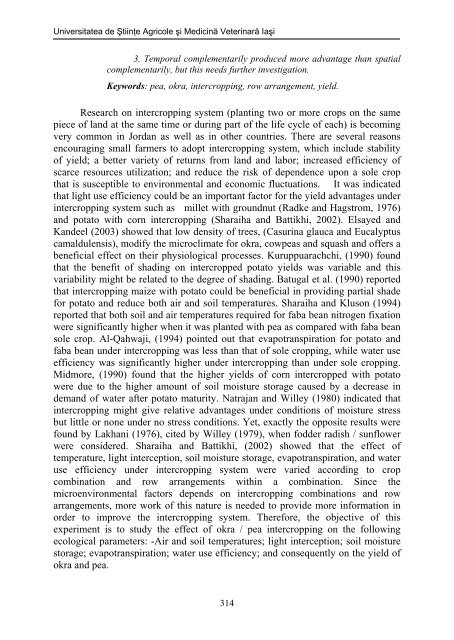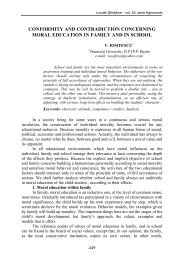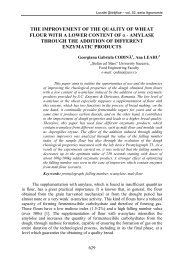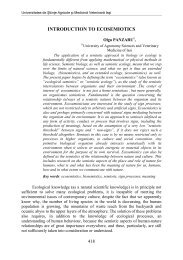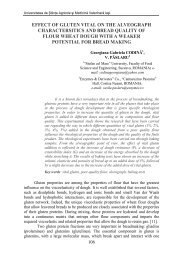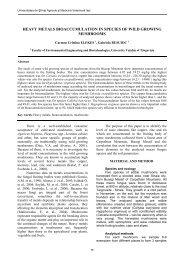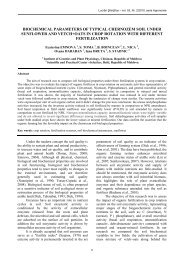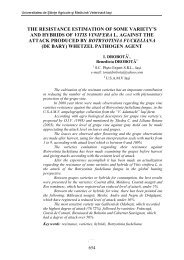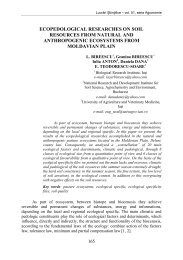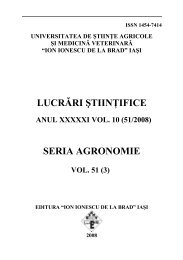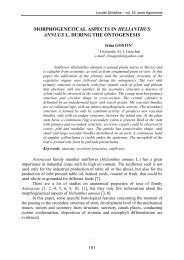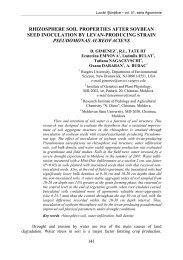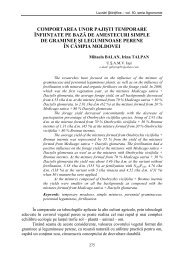environmental impact on yield of pea and okra grown under ...
environmental impact on yield of pea and okra grown under ...
environmental impact on yield of pea and okra grown under ...
You also want an ePaper? Increase the reach of your titles
YUMPU automatically turns print PDFs into web optimized ePapers that Google loves.
Universitatea de Ştiinţe Agricole şi Medicină Veterinară Iaşi<br />
3. Temporal complementarily produced more advantage than spatial<br />
complementarily, but this needs further investigati<strong>on</strong>.<br />
Keywords: <strong>pea</strong>, <strong>okra</strong>, intercropping, row arrangement, <strong>yield</strong>.<br />
Research <strong>on</strong> intercropping system (planting two or more crops <strong>on</strong> the same<br />
piece <strong>of</strong> l<strong>and</strong> at the same time or during part <strong>of</strong> the life cycle <strong>of</strong> each) is becoming<br />
very comm<strong>on</strong> in Jordan as well as in other countries. There are several reas<strong>on</strong>s<br />
encouraging small farmers to adopt intercropping system, which include stability<br />
<strong>of</strong> <strong>yield</strong>; a better variety <strong>of</strong> returns from l<strong>and</strong> <strong>and</strong> labor; increased efficiency <strong>of</strong><br />
scarce resources utilizati<strong>on</strong>; <strong>and</strong> reduce the risk <strong>of</strong> dependence up<strong>on</strong> a sole crop<br />
that is susceptible to <str<strong>on</strong>g>envir<strong>on</strong>mental</str<strong>on</strong>g> <strong>and</strong> ec<strong>on</strong>omic fluctuati<strong>on</strong>s. It was indicated<br />
that light use efficiency could be an important factor for the <strong>yield</strong> advantages <strong>under</strong><br />
intercropping system such as millet with groundnut (Radke <strong>and</strong> Hagstrom, 1976)<br />
<strong>and</strong> potato with corn intercropping (Sharaiha <strong>and</strong> Battikhi, 2002). Elsayed <strong>and</strong><br />
K<strong>and</strong>eel (2003) showed that low density <strong>of</strong> trees, (Casurina glauca <strong>and</strong> Eucalyptus<br />
camaldulensis), modify the microclimate for <strong>okra</strong>, cow<strong>pea</strong>s <strong>and</strong> squash <strong>and</strong> <strong>of</strong>fers a<br />
beneficial effect <strong>on</strong> their physiological processes. Kuruppuarachchi, (1990) found<br />
that the benefit <strong>of</strong> shading <strong>on</strong> intercropped potato <strong>yield</strong>s was variable <strong>and</strong> this<br />
variability might be related to the degree <strong>of</strong> shading. Batugal et al. (1990) reported<br />
that intercropping maize with potato could be beneficial in providing partial shade<br />
for potato <strong>and</strong> reduce both air <strong>and</strong> soil temperatures. Sharaiha <strong>and</strong> Klus<strong>on</strong> (1994)<br />
reported that both soil <strong>and</strong> air temperatures required for faba bean nitrogen fixati<strong>on</strong><br />
were significantly higher when it was planted with <strong>pea</strong> as compared with faba bean<br />
sole crop. Al-Qahwaji, (1994) pointed out that evapotranspirati<strong>on</strong> for potato <strong>and</strong><br />
faba bean <strong>under</strong> intercropping was less than that <strong>of</strong> sole cropping, while water use<br />
efficiency was significantly higher <strong>under</strong> intercropping than <strong>under</strong> sole cropping.<br />
Midmore, (1990) found that the higher <strong>yield</strong>s <strong>of</strong> corn intercropped with potato<br />
were due to the higher amount <strong>of</strong> soil moisture storage caused by a decrease in<br />
dem<strong>and</strong> <strong>of</strong> water after potato maturity. Natrajan <strong>and</strong> Willey (1980) indicated that<br />
intercropping might give relative advantages <strong>under</strong> c<strong>on</strong>diti<strong>on</strong>s <strong>of</strong> moisture stress<br />
but little or n<strong>on</strong>e <strong>under</strong> no stress c<strong>on</strong>diti<strong>on</strong>s. Yet, exactly the opposite results were<br />
found by Lakhani (1976), cited by Willey (1979), when fodder radish / sunflower<br />
were c<strong>on</strong>sidered. Sharaiha <strong>and</strong> Battikhi, (2002) showed that the effect <strong>of</strong><br />
temperature, light intercepti<strong>on</strong>, soil moisture storage, evapotranspirati<strong>on</strong>, <strong>and</strong> water<br />
use efficiency <strong>under</strong> intercropping system were varied according to crop<br />
combinati<strong>on</strong> <strong>and</strong> row arrangements within a combinati<strong>on</strong>. Since the<br />
micro<str<strong>on</strong>g>envir<strong>on</strong>mental</str<strong>on</strong>g> factors depends <strong>on</strong> intercropping combinati<strong>on</strong>s <strong>and</strong> row<br />
arrangements, more work <strong>of</strong> this nature is needed to provide more informati<strong>on</strong> in<br />
order to improve the intercropping system. Therefore, the objective <strong>of</strong> this<br />
experiment is to study the effect <strong>of</strong> <strong>okra</strong> / <strong>pea</strong> intercropping <strong>on</strong> the following<br />
ecological parameters: -Air <strong>and</strong> soil temperatures; light intercepti<strong>on</strong>; soil moisture<br />
storage; evapotranspirati<strong>on</strong>; water use efficiency; <strong>and</strong> c<strong>on</strong>sequently <strong>on</strong> the <strong>yield</strong> <strong>of</strong><br />
<strong>okra</strong> <strong>and</strong> <strong>pea</strong>.<br />
314


